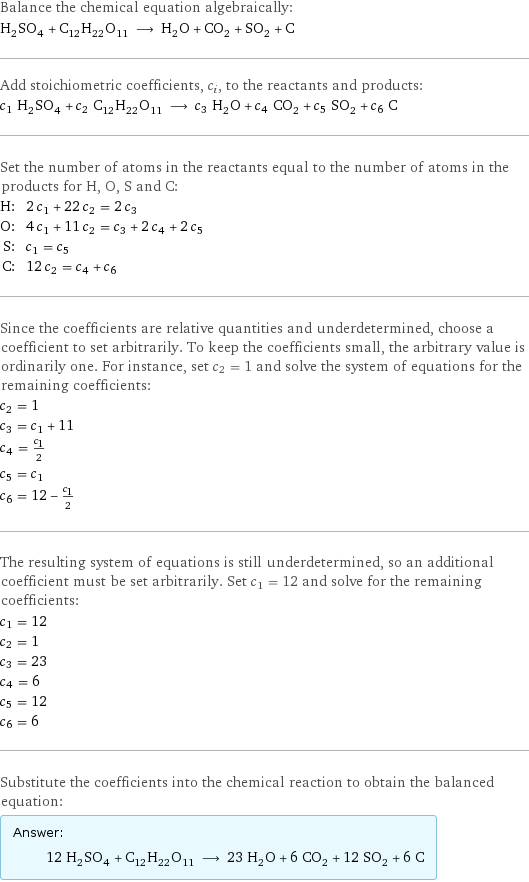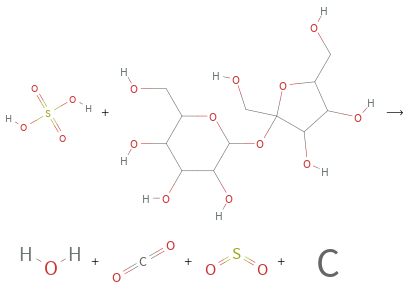Input interpretation

H_2SO_4 sulfuric acid + C_12H_22O_11 sucrose ⟶ H_2O water + CO_2 carbon dioxide + SO_2 sulfur dioxide + C activated charcoal
Balanced equation

Balance the chemical equation algebraically: H_2SO_4 + C_12H_22O_11 ⟶ H_2O + CO_2 + SO_2 + C Add stoichiometric coefficients, c_i, to the reactants and products: c_1 H_2SO_4 + c_2 C_12H_22O_11 ⟶ c_3 H_2O + c_4 CO_2 + c_5 SO_2 + c_6 C Set the number of atoms in the reactants equal to the number of atoms in the products for H, O, S and C: H: | 2 c_1 + 22 c_2 = 2 c_3 O: | 4 c_1 + 11 c_2 = c_3 + 2 c_4 + 2 c_5 S: | c_1 = c_5 C: | 12 c_2 = c_4 + c_6 Since the coefficients are relative quantities and underdetermined, choose a coefficient to set arbitrarily. To keep the coefficients small, the arbitrary value is ordinarily one. For instance, set c_2 = 1 and solve the system of equations for the remaining coefficients: c_2 = 1 c_3 = c_1 + 11 c_4 = c_1/2 c_5 = c_1 c_6 = 12 - c_1/2 The resulting system of equations is still underdetermined, so an additional coefficient must be set arbitrarily. Set c_1 = 12 and solve for the remaining coefficients: c_1 = 12 c_2 = 1 c_3 = 23 c_4 = 6 c_5 = 12 c_6 = 6 Substitute the coefficients into the chemical reaction to obtain the balanced equation: Answer: | | 12 H_2SO_4 + C_12H_22O_11 ⟶ 23 H_2O + 6 CO_2 + 12 SO_2 + 6 C
Structures

+ ⟶ + + +
Names

sulfuric acid + sucrose ⟶ water + carbon dioxide + sulfur dioxide + activated charcoal
Equilibrium constant
![Construct the equilibrium constant, K, expression for: H_2SO_4 + C_12H_22O_11 ⟶ H_2O + CO_2 + SO_2 + C Plan: • Balance the chemical equation. • Determine the stoichiometric numbers. • Assemble the activity expression for each chemical species. • Use the activity expressions to build the equilibrium constant expression. Write the balanced chemical equation: 12 H_2SO_4 + C_12H_22O_11 ⟶ 23 H_2O + 6 CO_2 + 12 SO_2 + 6 C Assign stoichiometric numbers, ν_i, using the stoichiometric coefficients, c_i, from the balanced chemical equation in the following manner: ν_i = -c_i for reactants and ν_i = c_i for products: chemical species | c_i | ν_i H_2SO_4 | 12 | -12 C_12H_22O_11 | 1 | -1 H_2O | 23 | 23 CO_2 | 6 | 6 SO_2 | 12 | 12 C | 6 | 6 Assemble the activity expressions accounting for the state of matter and ν_i: chemical species | c_i | ν_i | activity expression H_2SO_4 | 12 | -12 | ([H2SO4])^(-12) C_12H_22O_11 | 1 | -1 | ([C12H22O11])^(-1) H_2O | 23 | 23 | ([H2O])^23 CO_2 | 6 | 6 | ([CO2])^6 SO_2 | 12 | 12 | ([SO2])^12 C | 6 | 6 | ([C])^6 The equilibrium constant symbol in the concentration basis is: K_c Mulitply the activity expressions to arrive at the K_c expression: Answer: | | K_c = ([H2SO4])^(-12) ([C12H22O11])^(-1) ([H2O])^23 ([CO2])^6 ([SO2])^12 ([C])^6 = (([H2O])^23 ([CO2])^6 ([SO2])^12 ([C])^6)/(([H2SO4])^12 [C12H22O11])](../image_source/e13438336d8afc60e773594cdb1889a1.png)
Construct the equilibrium constant, K, expression for: H_2SO_4 + C_12H_22O_11 ⟶ H_2O + CO_2 + SO_2 + C Plan: • Balance the chemical equation. • Determine the stoichiometric numbers. • Assemble the activity expression for each chemical species. • Use the activity expressions to build the equilibrium constant expression. Write the balanced chemical equation: 12 H_2SO_4 + C_12H_22O_11 ⟶ 23 H_2O + 6 CO_2 + 12 SO_2 + 6 C Assign stoichiometric numbers, ν_i, using the stoichiometric coefficients, c_i, from the balanced chemical equation in the following manner: ν_i = -c_i for reactants and ν_i = c_i for products: chemical species | c_i | ν_i H_2SO_4 | 12 | -12 C_12H_22O_11 | 1 | -1 H_2O | 23 | 23 CO_2 | 6 | 6 SO_2 | 12 | 12 C | 6 | 6 Assemble the activity expressions accounting for the state of matter and ν_i: chemical species | c_i | ν_i | activity expression H_2SO_4 | 12 | -12 | ([H2SO4])^(-12) C_12H_22O_11 | 1 | -1 | ([C12H22O11])^(-1) H_2O | 23 | 23 | ([H2O])^23 CO_2 | 6 | 6 | ([CO2])^6 SO_2 | 12 | 12 | ([SO2])^12 C | 6 | 6 | ([C])^6 The equilibrium constant symbol in the concentration basis is: K_c Mulitply the activity expressions to arrive at the K_c expression: Answer: | | K_c = ([H2SO4])^(-12) ([C12H22O11])^(-1) ([H2O])^23 ([CO2])^6 ([SO2])^12 ([C])^6 = (([H2O])^23 ([CO2])^6 ([SO2])^12 ([C])^6)/(([H2SO4])^12 [C12H22O11])
Rate of reaction
![Construct the rate of reaction expression for: H_2SO_4 + C_12H_22O_11 ⟶ H_2O + CO_2 + SO_2 + C Plan: • Balance the chemical equation. • Determine the stoichiometric numbers. • Assemble the rate term for each chemical species. • Write the rate of reaction expression. Write the balanced chemical equation: 12 H_2SO_4 + C_12H_22O_11 ⟶ 23 H_2O + 6 CO_2 + 12 SO_2 + 6 C Assign stoichiometric numbers, ν_i, using the stoichiometric coefficients, c_i, from the balanced chemical equation in the following manner: ν_i = -c_i for reactants and ν_i = c_i for products: chemical species | c_i | ν_i H_2SO_4 | 12 | -12 C_12H_22O_11 | 1 | -1 H_2O | 23 | 23 CO_2 | 6 | 6 SO_2 | 12 | 12 C | 6 | 6 The rate term for each chemical species, B_i, is 1/ν_i(Δ[B_i])/(Δt) where [B_i] is the amount concentration and t is time: chemical species | c_i | ν_i | rate term H_2SO_4 | 12 | -12 | -1/12 (Δ[H2SO4])/(Δt) C_12H_22O_11 | 1 | -1 | -(Δ[C12H22O11])/(Δt) H_2O | 23 | 23 | 1/23 (Δ[H2O])/(Δt) CO_2 | 6 | 6 | 1/6 (Δ[CO2])/(Δt) SO_2 | 12 | 12 | 1/12 (Δ[SO2])/(Δt) C | 6 | 6 | 1/6 (Δ[C])/(Δt) (for infinitesimal rate of change, replace Δ with d) Set the rate terms equal to each other to arrive at the rate expression: Answer: | | rate = -1/12 (Δ[H2SO4])/(Δt) = -(Δ[C12H22O11])/(Δt) = 1/23 (Δ[H2O])/(Δt) = 1/6 (Δ[CO2])/(Δt) = 1/12 (Δ[SO2])/(Δt) = 1/6 (Δ[C])/(Δt) (assuming constant volume and no accumulation of intermediates or side products)](../image_source/794b54601e68f9bb1b7b49879c4526a5.png)
Construct the rate of reaction expression for: H_2SO_4 + C_12H_22O_11 ⟶ H_2O + CO_2 + SO_2 + C Plan: • Balance the chemical equation. • Determine the stoichiometric numbers. • Assemble the rate term for each chemical species. • Write the rate of reaction expression. Write the balanced chemical equation: 12 H_2SO_4 + C_12H_22O_11 ⟶ 23 H_2O + 6 CO_2 + 12 SO_2 + 6 C Assign stoichiometric numbers, ν_i, using the stoichiometric coefficients, c_i, from the balanced chemical equation in the following manner: ν_i = -c_i for reactants and ν_i = c_i for products: chemical species | c_i | ν_i H_2SO_4 | 12 | -12 C_12H_22O_11 | 1 | -1 H_2O | 23 | 23 CO_2 | 6 | 6 SO_2 | 12 | 12 C | 6 | 6 The rate term for each chemical species, B_i, is 1/ν_i(Δ[B_i])/(Δt) where [B_i] is the amount concentration and t is time: chemical species | c_i | ν_i | rate term H_2SO_4 | 12 | -12 | -1/12 (Δ[H2SO4])/(Δt) C_12H_22O_11 | 1 | -1 | -(Δ[C12H22O11])/(Δt) H_2O | 23 | 23 | 1/23 (Δ[H2O])/(Δt) CO_2 | 6 | 6 | 1/6 (Δ[CO2])/(Δt) SO_2 | 12 | 12 | 1/12 (Δ[SO2])/(Δt) C | 6 | 6 | 1/6 (Δ[C])/(Δt) (for infinitesimal rate of change, replace Δ with d) Set the rate terms equal to each other to arrive at the rate expression: Answer: | | rate = -1/12 (Δ[H2SO4])/(Δt) = -(Δ[C12H22O11])/(Δt) = 1/23 (Δ[H2O])/(Δt) = 1/6 (Δ[CO2])/(Δt) = 1/12 (Δ[SO2])/(Δt) = 1/6 (Δ[C])/(Δt) (assuming constant volume and no accumulation of intermediates or side products)
Chemical names and formulas
![| sulfuric acid | sucrose | water | carbon dioxide | sulfur dioxide | activated charcoal formula | H_2SO_4 | C_12H_22O_11 | H_2O | CO_2 | SO_2 | C Hill formula | H_2O_4S | C_12H_22O_11 | H_2O | CO_2 | O_2S | C name | sulfuric acid | sucrose | water | carbon dioxide | sulfur dioxide | activated charcoal IUPAC name | sulfuric acid | (2R, 3S, 4S, 5S, 6R)-2-[(2S, 3S, 4S, 5R)-3, 4-dihydroxy-2, 5-bis(hydroxymethyl)oxolan-2-yl]oxy-6-(hydroxymethyl)oxane-3, 4, 5-triol | water | carbon dioxide | sulfur dioxide | carbon](../image_source/37078626cc027d415c2a248115658a0c.png)
| sulfuric acid | sucrose | water | carbon dioxide | sulfur dioxide | activated charcoal formula | H_2SO_4 | C_12H_22O_11 | H_2O | CO_2 | SO_2 | C Hill formula | H_2O_4S | C_12H_22O_11 | H_2O | CO_2 | O_2S | C name | sulfuric acid | sucrose | water | carbon dioxide | sulfur dioxide | activated charcoal IUPAC name | sulfuric acid | (2R, 3S, 4S, 5S, 6R)-2-[(2S, 3S, 4S, 5R)-3, 4-dihydroxy-2, 5-bis(hydroxymethyl)oxolan-2-yl]oxy-6-(hydroxymethyl)oxane-3, 4, 5-triol | water | carbon dioxide | sulfur dioxide | carbon